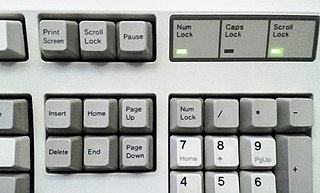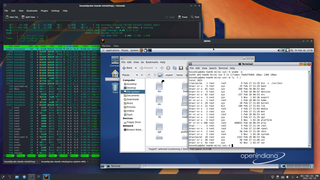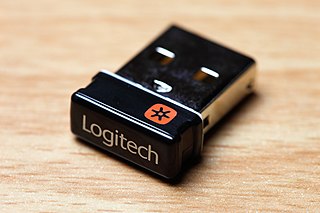

Dynamic device mapping is a technology for USB KVM switches which is sometimes implemented as an alternative to standard USB keyboard and mouse emulation.


Dynamic device mapping is a technology for USB KVM switches which is sometimes implemented as an alternative to standard USB keyboard and mouse emulation.
With DDM (Dynamic Device Mapping) Technology, the communication between shared peripherals and all connected systems are maintained 100% of the time, even as a user switches between the KVM ports. This makes generic device emulation unnecessary as the DDM allows each connected computer system to believe all connected I/O devices are remaining connected even as the KVM switch might move to another port.
Many USB KVM devices provide peripheral emulation, sending signals to the computers that are not currently selected to simulate a keyboard, mouse and monitor being connected. The emulation is used to avoid problems with machines which may reboot in unattended operation. Peripheral emulation services embedded in the hardware also provides continuous support where computers require constant communication with the peripherals. In addition, some types of computer systems do not treat USB devices as hot-pluggable, which means the keyboard and mouse will not be re-detected when switching back to a particular KVM port. For these types of systems, it is necessary to implement device emulation.
Standard device emulation has its limitations. When emulating a USB keyboard, mouse, and monitor it is impossible for most KVM's to simulate various types of I/O devices specifically. As a result, KVM switches will sometimes offer inconsistent performance and even sometimes unsolved compatibility issues with the shared keyboard, mouse, and other devices. The intent of Dynamic Device Mapping is to resolve the issues that standard device mapping sometimes faces.

A motherboard is the main printed circuit board (PCB) in general-purpose computers and other expandable systems. It holds and allows communication between many of the crucial electronic components of a system, such as the central processing unit (CPU) and memory, and provides connectors for other peripherals. Unlike a backplane, a motherboard usually contains significant sub-systems, such as the central processor, the chipset's input/output and memory controllers, interface connectors, and other components integrated for general use.

Scroll Lock is a lock key on most IBM-compatible computer keyboards. Depending on the operating system, it may be used for different purposes, and applications may assign functions to the key or change their behavior depending on its toggling state. The key is not frequently used, and therefore some reduced or specialized keyboards lack Scroll Lock altogether.

Universal Serial Bus (USB) is an industry standard that allows data exchange and delivery of power between many types of electronics. It specifies its architecture, in particular its physical interface, and communication protocols for data transfer and power delivery to and from hosts, such as personal computers, to and from peripheral devices, e.g. displays, keyboards, and mass storage devices, and to and from intermediate hubs, which multiply the number of a host's ports.
A human interface device or HID is a type of computer device usually used by humans that takes input from or provides output to humans.

A KVM switch is a hardware device that allows a user to control multiple computers from one or more sets of keyboards, video monitors, and mouse.

QEMU is a free and open-source emulator. It emulates a computer's processor through dynamic binary translation and provides a set of different hardware and device models for the machine, enabling it to run a variety of guest operating systems. It can interoperate with Kernel-based Virtual Machine (KVM) to run virtual machines at near-native speed. QEMU can also do emulation for user-level processes, allowing applications compiled for one processor architecture to run on another.
Multiplicity is a computer program that enables one keyboard and mouse to access two or more client computers from a host computer. It was developed for Stardock as part of their ThinkDesk subscription service, but is available separately.

USB On-The-Go is a specification first used in late 2001 that allows USB devices, such as tablets or smartphones, to also act as a host, allowing other USB devices, such as USB flash drives, digital cameras, mouse or keyboards, to be attached to them. Use of USB OTG allows devices to switch back and forth between the roles of host and device. For example, a smartphone may read from removable media as the host device, but present itself as a USB Mass Storage Device when connected to a host computer.

The PS/2 port is a 6-pin mini-DIN connector used for connecting keyboards and mice to a PC compatible computer system. Its name comes from the IBM Personal System/2 series of personal computers, with which it was introduced in 1987. The PS/2 mouse connector generally replaced the older DE-9 RS-232 "serial mouse" connector, while the PS/2 keyboard connector replaced the larger 5-pin/180° DIN connector used in the IBM PC/AT design. The PS/2 keyboard port is electrically and logically identical to the IBM AT keyboard port, differing only in the type of electrical connector used. The PS/2 platform introduced a second port with the same design as the keyboard port for use to connect a mouse; thus the PS/2-style keyboard and mouse interfaces are electrically similar and employ the same communication protocol. However, unlike the otherwise similar Apple Desktop Bus connector used by Apple, a given system's keyboard and mouse port may not be interchangeable since the two devices use different sets of commands and the device drivers generally are hard-coded to communicate with each device at the address of the port that is conventionally assigned to that device.
In computing, the USB human interface device class is a part of the USB specification for computer peripherals: it specifies a device class for human interface devices such as keyboards, mice, game controllers and alphanumeric display devices.

A multiseat, multi-station or multiterminal system is a single computer which supports multiple independent local users at the same time.

A computer port is a hardware piece on a computer where an electrical connector can be plugged to link the device to external devices, such as another computer, a peripheral device or network equipment.This is a non-standard term.
DDM may refer to:
In computing, the term remote desktop refers to a software- or operating system feature that allows a personal computer's desktop environment to be run remotely from one system, while being displayed on a separate client device. Remote desktop applications have varying features. Some allow attaching to an existing user's session and "remote controlling", either displaying the remote control session or blanking the screen. Taking over a desktop remotely is a form of remote administration.
A headless computer is a computer system or device that has been configured to operate without a monitor, keyboard, and mouse. A headless system is typically controlled over a network connection, although some headless system devices require a serial connection to be made over RS-232 for administration of the device. Headless operation of a server is typically employed to reduce operating costs.
This glossary of computer hardware terms is a list of definitions of terms and concepts related to computer hardware, i.e. the physical and structural components of computers, architectural issues, and peripheral devices.

The Logitech Unifying Receiver is a small dedicated USB wireless receiver, based on the nRF24L-family of RF devices, that allows up to six compatible Logitech human interface devices to be linked to the same computer using 2.4 GHz band radio communication. Receivers that are bundled with a Logitech product are paired with the device at the factory. When purchasing a replacement receiver or connecting multiple devices to one receiver, pairing requires the free-of-charge Logitech Unifying software, available for Microsoft Windows and Mac OS X. On Linux the Solaar software can be used to adjust the configurations. Although not compatible with Bluetooth, devices pair to Unifying Receivers in a similar way. Peripherals remain paired, and can then be used on systems not supporting the software. Logitech receivers compatible with the Unifying protocol can be identified by the orange Unifying logo, which distinguishes them from Logitech Nano receivers of similar appearance, which pair in a similar manner but only with a single device, without using the Unifying protocol.

ATEN International Co.(Ltd) is a multinational manufacturer of connectivity and access management hardware headquartered in Xizhi District, New Taipei, Taiwan. Its products include KVM switches, audiovisual switches and matrices, intelligent power distribution units, information technology management systems, and interface adapters. ATEN has subsidiaries in several countries and is the parent company of IOGEAR.

A KVMSplitter, also known as a Reverse KVM switch, is a hardware device that allows users to control a single computer from one or more sets of keyboards, video monitors, and mice. With a KVM splitter, users access the connected computer consecutively rather than simultaneously. It differs from a KVM Switch which allows multiple computers to be controlled, usually, by a single keyboard, monitor and mouse.